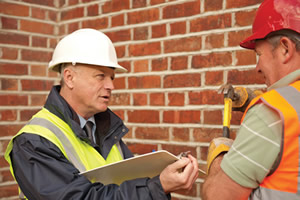Meeting the Challenge

PHOTOS COURTESY OF THE INSTITUTE FOR BUILDING TECHNOLOGY AND SAFETY
The Department of General Services (DGS) used both school maintenance personnel and licensed contractors to address maintenance concerns located with the D.C. school building system. In-house maintenance items and larger contracted items, such as HVAC, roof repair, painting, plumbing and electrical repair are delineated for areas of responsibilities and assigned.
During the 2015 “Spring Break Blitz,” DGS encountered a challenge. Given the limited time constraints of the “blitz,” DGS had to find a way to coordinate maintenance staff and licensed contractors to ensure work was completed timely and in a workmanlike manner. In addition, DGS had to address reporting expectations for monitoring, daily progress, and final reporting. DGS hired the Institute for Building Technology and Safety (IBTS), a 501(c)(3) non-profit based in Ashburn, Va. to provide monitoring and reporting services.
The “Spring Break Blitz” included elementary, middle and high schools of varying ages in need of various repairs. IBTS was asked to provide monitoring of previous and ongoing work. After a brief meeting with DGS, where expectations were outlined, IBTS began immediate monitoring, working within the limited time frame.
To provide solutions to the challenges listed, IBTS offered the following:
- Rapid mobilization: Monitoring personnel were deployed within hours of receiving monitoring criteria from the client.
- Guidance: Supervisory staff were immediately dispatched to provide guidance, leadership, and oversight of field personnel.
- Coordination: IBTS employed a single point of contact who established a master list of complete vs incomplete work. The single point of contact kept the master list updated as monitoring results came in.
- A finalized report with photographs was provided to the client within days of project completion.
After the conclusion of this project, IBTS identified Lessons Learned that could be of value to DGS and other school systems facing similar challenges:
- The maintenance supervisor should be available to ensure all areas of concern are open and accessible for monitoring and to provide assistance finding the appropriate locations within the school. As an alternate, keys and a clearly labeled floor plan for each school can be provided. Either approach will reduce the time spent locating areas needing monitoring, thus improving quality, and reducing the time spent at each school.
- The scope of work provided should clearly define items by floor and room. In addition, scope should be structured to ensure duplicative requests for repairs are not listed.
- If not already developed, a complete scope of work for each trade, including the methods, materials, and procedures, should be developed and provided to each stakeholder. This will ensure all parties involved understand the expectations and provide quality repairs.
- Monitoring services should be engaged as early in the process as possible to ensure as work progresses, it is completed timely, in a professional and workman like manner, and within the pre-established scope of work.
- Licensed contractor accountability should be clearly defined. Each contractor should provide daily updates of work started, hours spent on each task, and when each item is completed. Critical deadlines for work progression should be established prior to work beginning. For instance, 25-percent, 50-percent, 75-percent and 100-percent completion deadlines should be established and verified.
- A single, comprehensive, standardized format for collection, photographic storage, and distribution of daily and final reporting information should be developed and used by all stakeholders.
- A single supervisory point of contact should be established by each stakeholder to assist in monitoring the completion of work.
- Expectations related to the scope of work should be clearly defined in writing, outlining each stakeholder’s area of responsibilities.
Monitoring of maintenance and contract work can be successfully provided to any school district. Although it may appear the labor force, construction work, materials, monitoring, and reporting seems to be self-explanatory, in reality, it is not. Better results can be expected when relationships are established earlier in the process, methodologies are well thought-out, specific responsibilities are clearly defined, and a team approach is used to ensure all work is completed in a qualified and timely manner.
This article originally appeared in the issue of .
About the Author
Rick Wilburg has more than 15 years of experience as a Certified Building Official and combination commercial inspector. He is skilled at performing and leading building code reviews and inspections for commercial and residential projects.